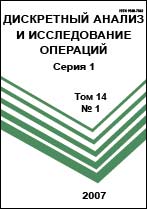|
This article is cited in 1 scientific paper (total in 1 paper)
Discrete facility location in machine learning
I. L. Vasilyev, A. V. Ushakov
Matrosov Institute for System Dynamics and Control Theory, 134 Lermontov Street, 664033 Irkutsk, Russia
Abstract:
Facility location problems form a wide class of optimization problems, extremely popular in combinatorial optimization and operations research. In any facility location problem, one must locate a set of facilities in order to satisfy the demands of customers so as a certain objective function is optimized. Besides numerous applications in public and private sectors, the problems are widely used in machine learning. For example, clustering can be viewed as a facility location problem where one needs to partition a set of customers into clusters assigned to open facilities. In this survey we briefly look at how ideas and approaches arisen in the field of facility location led to modern, popular machine learning algorithms supported by many data mining and machine learning software packages. We also review the state-of-the-art exact methods and heuristics, as well as some extensions of basic problems and algorithms arisen in applied machine learning tasks. Note that the main emphasis here lies on discrete facility location problems, which, for example, underlie many widely used clustering algorithms (PAM, affinity propagation, etc.). Since the high computational complexity of conventional facility location-based clustering algorithms hinders their application to modern large-scale real-life datasets, we also survey some modern approaches to implementation of the algorithms for such large data collections. Bibliogr. 138.
Keywords:
machine learning, facility location, clustering.
Received: 30.04.2021
Revised: 17.06.2021
Accepted: 21.06.2021
Citation:
I. L. Vasilyev, A. V. Ushakov, “Discrete facility location in machine learning”, Diskretn. Anal. Issled. Oper., 28:4 (2021), 5–60
Linking options:
https://www.mathnet.ru/eng/da1284 https://www.mathnet.ru/eng/da/v28/i4/p5
|

| Statistics & downloads: |
| Abstract page: | 395 | | Full-text PDF : | 200 | | References: | 33 | | First page: | 17 |
|




 Contact us:
Contact us: Terms of Use
Terms of Use
 Registration to the website
Registration to the website Logotypes
Logotypes







 Citation in format
Citation in format 
